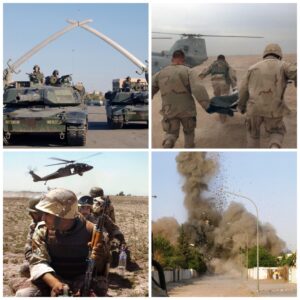This Veterans Day let’s honor our Veterans by ending their wars by repealing the 1957, 1991, 2001, and 2002 AUMFs.
As we approach Veterans Day, we reflect on the sacrifices our service members have made in service to our county. One of the most solemn promises a nation can make to its veterans is to use military force judiciously and only when absolutely necessary. However, several outdated Authorizations for Use of Military Force (AUMFs) remain active, giving the executive branch far-reaching authority to engage in military action without the explicit approval of Congress. The 1957, 1991, 2001, and 2002 AUMFs are still in effect, providing broad justifications for military engagements that allow the President to strike targets at will.
To truly honor our veterans this Veterans Day, we must push for the repeal of these outdated AUMFs, restoring constitutional checks on the executive’s power to wage war and ensuring that military action is only pursued with clear and current defensive justification.
The Legacy of the AUMFs
- The 1957 AUMF: Passed during the Cold War era, this authorization was a product of intense geopolitical tension between the United States and the Soviet Union. Designed to counter potential Soviet expansion in the Middle East, it granted the president broad authority to use military force to protect U.S. allies in the region. While the Cold War has long since ended, this AUMF technically remains in effect, though rarely invoked in modern times.
- The 1991 AUMF: Passed in the lead-up to the Gulf War, the 1991 AUMF gave President George H.W. Bush the authority to use military force to expel Iraqi forces from Kuwait. The Gulf War ended decades ago, and Saddam Hussein’s regime is no longer a threat, but the 1991 AUMF remains on the books.
- The 2001 AUMF: This is perhaps the most well-known and widely abused of the AUMFs. Passed just days after the September 11, 2001, attacks, it authorized the use of force against those responsible for the attacks and any associated forces. However, its vague language has led to a nearly boundless interpretation, allowing it to be used as a justification for military actions across the globe, from Afghanistan to Yemen, often with little connection to the original target of the authorization al-Qaeda.
- The 2002 AUMF: Passed in the run-up to the invasion of Iraq in 2003, this AUMF was designed to remove Saddam Hussein’s regime from power. While Saddam has been gone for over 15 years, the 2002 AUMF continues to be used as a justification for military action, often far beyond the original scope of its intent. In fact, the Trump and Biden administrations both invoked the 2002 AUMF in unrelated military operations.
Why Repeal Is Essential
Restoring Constitutional Balance: The Constitution grants Congress the power to declare war, a vital check on executive overreach. However, these lingering AUMFs have effectively transferred much of that power to the executive branch. Presidents from both parties have used the 2001 and 2002 AUMFs to engage in military actions without seeking updated congressional approval. This undermines the democratic principle that major military engagements should only occur with the consent of the people’s representatives in Congress. Repealing these outdated AUMFs would restore the proper constitutional balance, ensuring that the decision to go to war is thoroughly debated and scrutinized.
Preventing Perpetual War: The 2001 and 2002 AUMFs, in particular, have enabled a state of perpetual war, with military actions justified in countries and regions that had no connection to the original authorizations. Repealing these AUMFs would force a reassessment of current military engagements and demand a renewed focus on diplomacy and conflict resolution. Veterans who served in these prolonged conflicts have frequently expressed frustration with the seemingly endless nature of these wars. By repealing outdated AUMFs, we send a message that military force is not an indefinite solution and that there is a clear path to peace.
Honoring Veterans’ Sacrifices: Every time the United States engages in military action, it asks its service members to risk their lives. Veterans, many of whom have served multiple tours in conflicts authorized under the 2001 and 2002 AUMFs, deserve to know that their sacrifices are made in the service of clearly defined, lawful, and necessary missions. Leaving outdated AUMFs in place not only dishonors their service but risks further entanglement in conflicts with murky justifications. Repealing these authorizations would be a powerful statement that the U.S. government is committed to using military force sparingly, with the full weight of congressional approval.
Aligning Military Action with Today’s Realities: The world has changed drastically since 1957, 1991, 2001, and 2002. The Cold War is long over, the Gulf War is a distant memory, and the geopolitical landscape in the Middle East has shifted considerably. Continuing to rely on these outdated AUMFs leaves the door open for military action that is detached from current realities. If new threats emerge, Congress should debate and vote on new authorizations tailored to those specific challenges, rather than relying on antiquated justifications.
A Path Forward
In recent years, there has been bipartisan support for repealing these outdated AUMFs. In 2021, the House of Representatives passed a bill to repeal the 2002 AUMF, and there have been efforts to repeal or replace the 2001 AUMF. However, these efforts have not yet been fully realized. As Veterans Day approaches, there is no better time to renew the push for repeal.
Veterans fought and sacrificed for our country. By repealing these outdated AUMFs, we ensure that military force is used only when absolutely necessary and with full democratic oversight. This is how we can truly honor the sacrifices of those who have served and ensure that future generations are not sent into harm’s way without clear and current justification.
This Veterans Day, let us recommit ourselves to protecting the rights and freedoms our veterans have fought for, by restoring constitutional limits on the use of military force.

